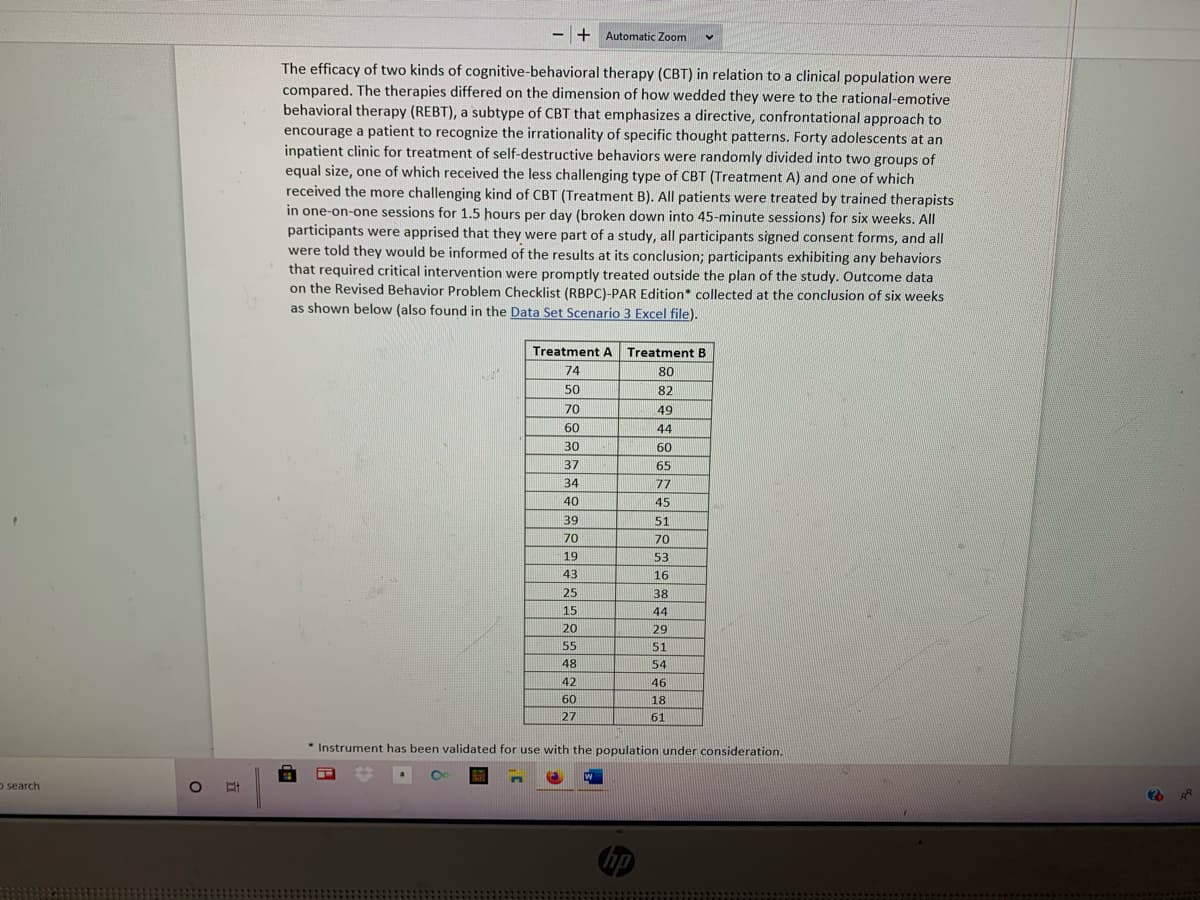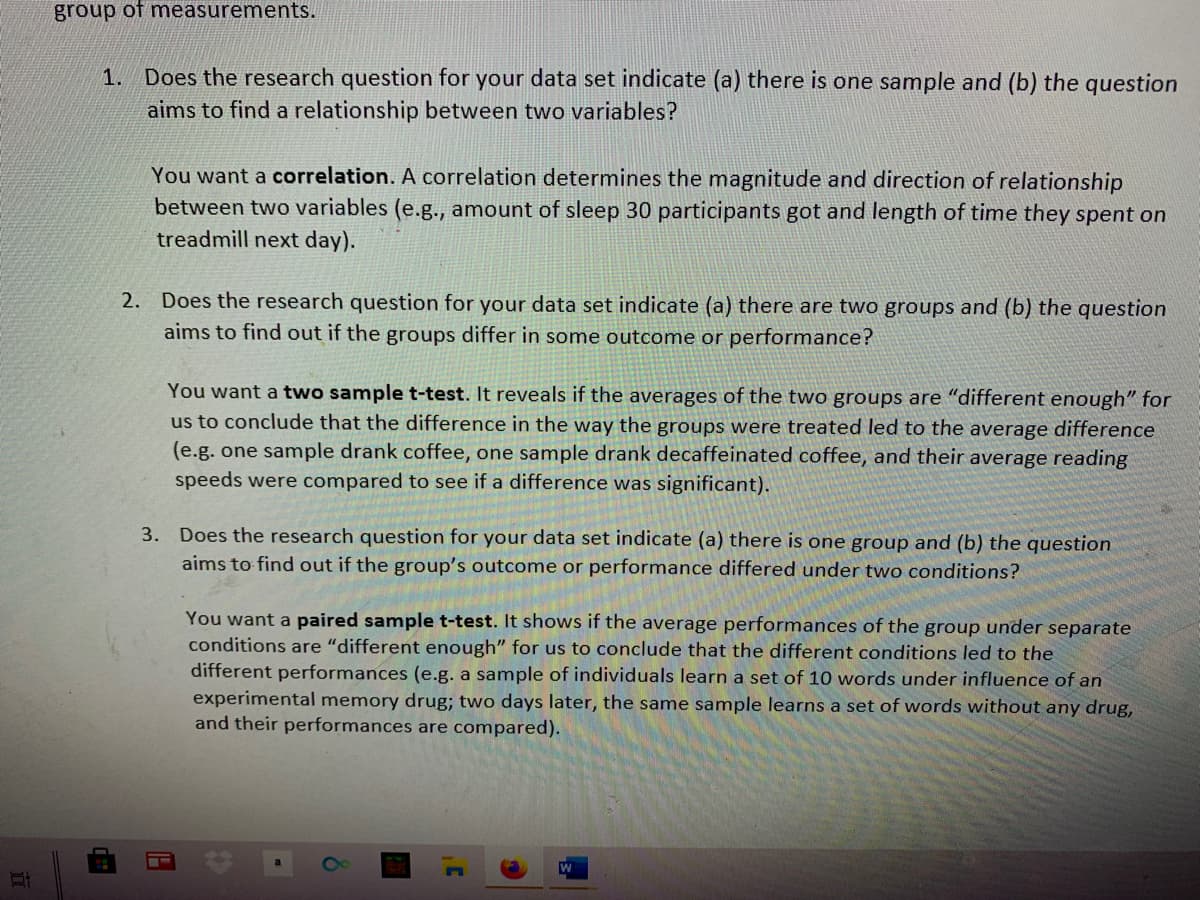The efficacy of two kinds of cognitive-behavioral therapy (CBT) in relation to a clinical population were compared. The therapies differed on the dimension of how wedded they were to the rational-emotive behavioral therapy (REBT), a subtype of CBT that emphasizes a directive, confrontational approach to encourage a patient to recognize the irrationality of specific thought patterns. Forty adolescents at an inpatient clinic for treatment of self-destructive behaviors were randomly divided into two groups of equal size, one of which received the less challenging type of CBT (Treatment A) and one of which received the more challenging kind of CBT (Treatment B). All patients were treated by trained therapists in one-on-one sessions for 1.5 hours per day (broken down into 45-minute sessions) for six weeks. All participants were apprised that they were part of a study, all participants signed consent forms, and all were told they would be informed of the results at its conclusion; participants exhibiting any behaviors that required critical intervention were promptly treated outside the plan of the study. Outcome data on the Revised Behavior Problem Checklist (RBPC)-PAR Edition* collected at the conclusion of six weeks as shown below Jalse f.
The efficacy of two kinds of cognitive-behavioral therapy (CBT) in relation to a clinical population were compared. The therapies differed on the dimension of how wedded they were to the rational-emotive behavioral therapy (REBT), a subtype of CBT that emphasizes a directive, confrontational approach to encourage a patient to recognize the irrationality of specific thought patterns. Forty adolescents at an inpatient clinic for treatment of self-destructive behaviors were randomly divided into two groups of equal size, one of which received the less challenging type of CBT (Treatment A) and one of which received the more challenging kind of CBT (Treatment B). All patients were treated by trained therapists in one-on-one sessions for 1.5 hours per day (broken down into 45-minute sessions) for six weeks. All participants were apprised that they were part of a study, all participants signed consent forms, and all were told they would be informed of the results at its conclusion; participants exhibiting any behaviors that required critical intervention were promptly treated outside the plan of the study. Outcome data on the Revised Behavior Problem Checklist (RBPC)-PAR Edition* collected at the conclusion of six weeks as shown below Jalse f.
Chapter6: Systems Of Equations And Inequalities
Section: Chapter Questions
Problem 17PS: Cholesterol Cholesterol in human blood is necessary, but too much can lead to health problems. There...
Related questions
Question
Which statistical procedure would be the best way to solve this analysis?

Transcribed Image Text:+ Automatic Zoom
The efficacy of two kinds of cognitive-behavioral therapy (CBT) in relation to a clinical population were
compared. The therapies differed on the dimension of how wedded they were to the rational-emotive
behavioral therapy (REBT), a subtype of CBT that emphasizes a directive, confrontational approach to
encourage a patient to recognize the irrationality of specific thought patterns. Forty adolescents at an
inpatient clinic for treatment of self-destructive behaviors were randomly divided into two groups of
equal size, one of which received the less challenging type of CBT (Treatment A) and one of which
received the more challenging kind of CBT (Treatment B). All patients were treated by trained therapists
in one-on-one sessions for 1.5 hours per day (broken down into 45-minute sessions) for six weeks. All
participants were apprised that they were part of a study, all participants signed consent forms, and all
were told they would be informed of the results at its conclusion; participants exhibiting any behaviors
that required critical intervention were promptly treated outside the plan of the study. Outcome data
on the Revised Behavior Problem Checklist (RBPC)-PAR Edition* collected at the conclusion of six weeks
as shown below (also found in the Data Set Scenario 3 Excel file).
Treatment A
Treatment B
74
80
50
82
70
49
60
44
30
60
37
65
34
77
40
45
39
51
70
70
19
53
43
16
25
38
15
44
20
29
55
51
48
54
42
46
60
18
27
61
Instrument has been validated for use with the population under consideration.
O search
op

Transcribed Image Text:group of measurements.
1. Does the research question for your data set indicate (a) there is one sample and (b) the question
aims to find a relationship between two variables?
You want a correlation. A correlation determines the magnitude and direction of relationship
between two variables (e.g., amount of sleep 30 participants got and length of time they spent on
treadmill next day).
2. Does the research question for your data set indicate (a) there are two groups and (b) the question
aims to find out if the groups differ in some outcome or performance?
You want a two sample t-test. It reveals if the averages of the two groups are "different enough" for
us to conclude that the difference in the way the groups were treated led to the average difference
(e.g. one sample drank coffee, one sample drank decaffeinated coffee, and their average reading
speeds were compared to see if a difference was significant).
3.
Does the research question for your data set indicate (a) there is one group and (b) the question
aims to find out if the group's outcome or performance differed under two conditions?
You want a paired sample t-test. It shows if the average performances of the group under separate
conditions are "different enough" for us to conclude that the different conditions led to the
different performances (e.g. a sample of individuals learn a set of 10 words under influence of an
experimental memory drug; two days later, the same sample learns a set of words without any drug,
and their performances are compared).
Expert Solution
This question has been solved!
Explore an expertly crafted, step-by-step solution for a thorough understanding of key concepts.
This is a popular solution!
Trending now
This is a popular solution!
Step by step
Solved in 2 steps

Knowledge Booster
Learn more about
Need a deep-dive on the concept behind this application? Look no further. Learn more about this topic, statistics and related others by exploring similar questions and additional content below.Recommended textbooks for you


Glencoe Algebra 1, Student Edition, 9780079039897…
Algebra
ISBN:
9780079039897
Author:
Carter
Publisher:
McGraw Hill

Big Ideas Math A Bridge To Success Algebra 1: Stu…
Algebra
ISBN:
9781680331141
Author:
HOUGHTON MIFFLIN HARCOURT
Publisher:
Houghton Mifflin Harcourt


Glencoe Algebra 1, Student Edition, 9780079039897…
Algebra
ISBN:
9780079039897
Author:
Carter
Publisher:
McGraw Hill

Big Ideas Math A Bridge To Success Algebra 1: Stu…
Algebra
ISBN:
9781680331141
Author:
HOUGHTON MIFFLIN HARCOURT
Publisher:
Houghton Mifflin Harcourt